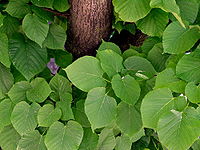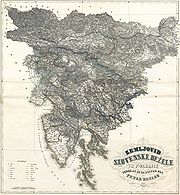
National symbols of Slovenia
Encyclopedia

Slovenia
Slovenia , officially the Republic of Slovenia , is a country in Central and Southeastern Europe touching the Alps and bordering the Mediterranean. Slovenia borders Italy to the west, Croatia to the south and east, Hungary to the northeast, and Austria to the north, and also has a small portion of...
and abroad to represent the nation and its people.
Political and ethnic symbols:
- The most common and recognizable of these is the Flag of SloveniaFlag of SloveniaThe national flag of Slovenia features three equal horizontal bands of white , blue, and red, with the Slovenian coat of arms located in the upper hoist side of the flag centered in the white and blue bands...
. - The Coat of arms of SloveniaCoat of arms of SloveniaThe Slovenian coat of arms consists of a red bordered blue shield on which there is a stylised white mount Triglav. Under Triglav there are two bending lines that represent the sea and rivers, and above Triglav there are three golden, six-pointed stars, forming a triangle...
, a part of the flag itself. - A leaf of a LindenTiliaTilia is a genus of about 30 species of trees native throughout most of the temperate Northern Hemisphere. The greatest species diversity is found in Asia, and the genus also occurs in Europe and eastern North America, but not western North America...
or Lime tree, an important part of Slovene national heritage. Village assemblies, councils and other gatherings were traditionally held around circular tables beneath such a tree.
- The stylized graphical representation of the three peaks of Mount TriglavTriglavTriglav is the highest mountain in Slovenia and the highest peak of the Julian Alps. While its name, meaning "three-headed", can describe its shape as seen from the Bohinj area, the mountain was most probably named after the Slavic god Triglav. The mountain is the preeminent symbol of the Slovene...
, the central device of the current coat of armsCoat of arms of SloveniaThe Slovenian coat of arms consists of a red bordered blue shield on which there is a stylised white mount Triglav. Under Triglav there are two bending lines that represent the sea and rivers, and above Triglav there are three golden, six-pointed stars, forming a triangle...
, has functioned as a national symbol since WWII, having been the emblem of the Liberation Front and subsequent communist-era arms. - The coat of arms of CarniolaCarniolaCarniola was a historical region that comprised parts of what is now Slovenia. As part of Austria-Hungary, the region was a crown land officially known as the Duchy of Carniola until 1918. In 1849, the region was subdivided into Upper Carniola, Lower Carniola, and Inner Carniola...
or just its eagle are still considered national symbols, being the signs of one of the two historical Slavic duchies, CarniolaCarniolaCarniola was a historical region that comprised parts of what is now Slovenia. As part of Austria-Hungary, the region was a crown land officially known as the Duchy of Carniola until 1918. In 1849, the region was subdivided into Upper Carniola, Lower Carniola, and Inner Carniola...
and Carantania, but are considered historic rather than current ones. - The principal symbols of Carantania, such as the Prince's StonePrince's StoneThe Prince's Stone is the reversed base of an ancient Ionic column that played an important role in the ceremony surrounding the installation of the princes of Carantania in the Early Middle Ages...
and the Duke's ChairDuke's ChairThe Duke's Chair, also known as the Duke's Seat , is a medieval stone seat dating from the ninth century and located at the Zollfeld plain near Maria Saal north of Klagenfurt in the Austrian state of Carinthia.-History:...
, are considered Slovene national symbols by Slovenes, but this point of view is opposed by certain Slovene scholars and many AustriaAustriaAustria , officially the Republic of Austria , is a landlocked country of roughly 8.4 million people in Central Europe. It is bordered by the Czech Republic and Germany to the north, Slovakia and Hungary to the east, Slovenia and Italy to the south, and Switzerland and Liechtenstein to the...
ns, most notably Jörg HaiderJörg HaiderJörg Haider was an Austrian politician. He was Governor of Carinthia on two occasions, the long-time leader of the Austrian Freedom Party and later Chairman of the Alliance for the Future of Austria , a breakaway party from the FPÖ.Haider was controversial within Austria and abroad for comments...
, the latter claiming them as Austria's political heritage.
- In the late 1980s, several symbols from the Middle AgesMiddle AgesThe Middle Ages is a periodization of European history from the 5th century to the 15th century. The Middle Ages follows the fall of the Western Roman Empire in 476 and precedes the Early Modern Era. It is the middle period of a three-period division of Western history: Classic, Medieval and Modern...
were revived as Slovenian national symbols, though their use is largely restricted to nationalist circles. Among them, the most popular are the so-called Slovene Hat, the crest of the coat of arms of the Slovene MarchWindic marchThe Windic march or marca Vindica was a province of the Holy Roman Empire in the Middle Ages, corresponding more or less to modern Lower Carniola in Slovenia. In Medieval German language, the term "Windisch" was a common name for some Slavic peoples The Windic march or marca Vindica was a...
, and the Black PantherBlack panther (symbol)Black panther is a Carinthian historical symbol, which represents a stilized heraldic panther. As a heraldic symbol, it appeared on the coat of arms of the Carinthian Duke Herman II as well as of the Styrian Margrave Ottokar III...
, a reconstruction of the supposed coat of arms of the principality of Carantania.
- Peter Kozler
 Peter KozlerPeter Kozler or Kosler was a Slovene lawyer, geographer, cartographer, activist and manufacturer...
Peter KozlerPeter Kozler or Kosler was a Slovene lawyer, geographer, cartographer, activist and manufacturer...
's 19th-century map of the Slovene LandsSlovene LandsSlovene Lands or Slovenian Lands is the historical denomination for the whole of the Slovene-inhabited territories in Central Europe. It more or less corresponds to modern Slovenia and the adjacent territories in Italy, Austria and Hungary in which autochthonous Slovene minorities live.-...
has been used as a symbolic representation for United SloveniaUnited SloveniaUnited Slovenia is the name of an unrealized political programme of the Slovene national movement, formulated during the Spring of Nations in 1848...
. Since the 1980s, it has been used as a symbolic representation for the "common Slovenian cultural area" ( or Enotni slovenski kulturni prostor) which transcends national borders.
Cultural symbols:
- Another symbol connected to Triglav comes from the folktale of the ZlatorogZlatorogGoldhorn or Goldenhorn is a legendary white chamois buck, or in some Slovenian stories the steinbock, who had his realm in the heights of Mount Triglav...
or "Goldenhorn," a mythical chamoisChamoisThe chamois, Rupicapra rupicapra, is a goat-antelope species native to mountains in Europe, including the Carpathian Mountains of Romania, the European Alps, the Tatra Mountains, the Balkans, parts of Turkey, and the Caucasus. The chamois has also been introduced to the South Island of New Zealand...
living in an enchanted garden near its summit. - The carnation is widely cultivated in Slovenia; the red carnation in particular is considered the national flower.
- Creatures endemic to Slovenia, including the OlmOlmThe olm, or proteus , is a blind amphibian endemic to the subterranean waters of caves of the Dinaric karst of southern Europe. It lives in the waters that flow underground through this extensive limestone region including waters of the Soča river basin near Trieste in Italy, through to southern...
, the Carniolan honey bee or the LipizzanLipizzanThe Lipizzan or Lipizzaner , is a breed of horse closely associated with the Spanish Riding School of Vienna, Austria, where the finest representatives demonstrate the haute école or "high school" movements of classical dressage, including the highly controlled, stylized jumps and other movements...
er horse are sometimes also considered as representing the Slovene national identity. - The painting of The Sower by Ivan GroharIvan GroharIvan Grohar was a Slovene Impressionist painter. Together with Rihard Jakopič, Matej Sternen and Matija Jama, he is considered one of the leading figures of Slovene impressionism in the fin de siecle period.- Life :...
, writings by the Slovene Protestant reformer Primož TrubarPrimož TrubarPrimož Trubar or Primož Truber was a Slovene Protestant reformer, the founder and the first superintendent of the Protestant Church of the Slovene Lands, a consolidator of the Slovene language and the author of the first Slovene-language printed book...
and the Slovene national poet France PrešerenFrance PrešerenFrance Prešeren was a Slovene Romantic poet. He is considered the Slovene national poet. Although he was not a particularly prolific author, he inspired virtually all Slovene literature thereafter....
are also considered national symbols. The latter's work includes the national anthem. - Distinctive architecture such as the KozolecKozolecA kozolec is a freestanding vertical drying rack found chiefly in Slovenia. They are permanent structures, primarily made of wood, upon which fodder for animals is dried...
(a type of hayrack) also fits into this category, notably the double kozolec known as a"toplar."
See also
- Slovenes
- Slovene LandsSlovene LandsSlovene Lands or Slovenian Lands is the historical denomination for the whole of the Slovene-inhabited territories in Central Europe. It more or less corresponds to modern Slovenia and the adjacent territories in Italy, Austria and Hungary in which autochthonous Slovene minorities live.-...
- History of SloveniaHistory of SloveniaThe history of Slovenia chronicles the period of the Slovene territory from the 5th Century BC to the present times. In the Early Bronze Age, Proto-Illyrian tribes settled an area stretching from present-day Albania to the city of Trieste. The Holy Roman Empire controlled the land for nearly 1,000...
- Culture of SloveniaCulture of SloveniaSlovenia's first book was printed by the Protestant reformer Primož Trubar . It was actually two books, Katekizem and Abecednik, which was published in 1550 in Tübingen, Germany....
- Slovenian euro coinsSlovenian euro coinsSlovenian euro coins were first issued for circulation on 1 January 2007 and a unique feature is designed for each coin. The design of approximately 230 million Slovenian euro coins was unveiled on 7 October 2005. The designers were Miljenko Licul, Maja Licul and Janez Boljka...
- Black panther (symbol)Black panther (symbol)Black panther is a Carinthian historical symbol, which represents a stilized heraldic panther. As a heraldic symbol, it appeared on the coat of arms of the Carinthian Duke Herman II as well as of the Styrian Margrave Ottokar III...

